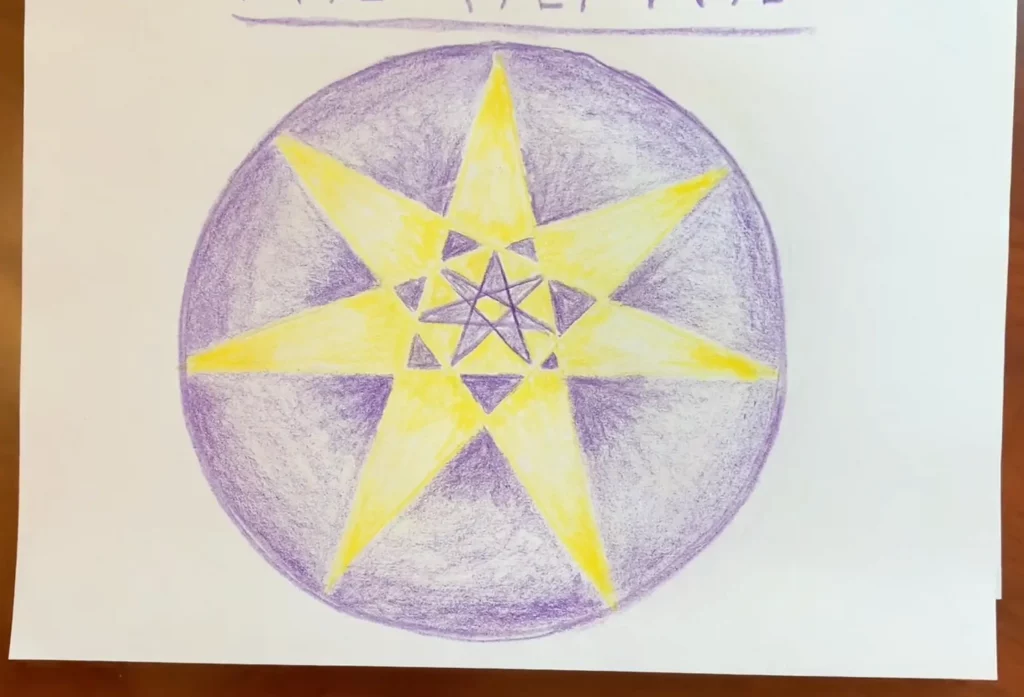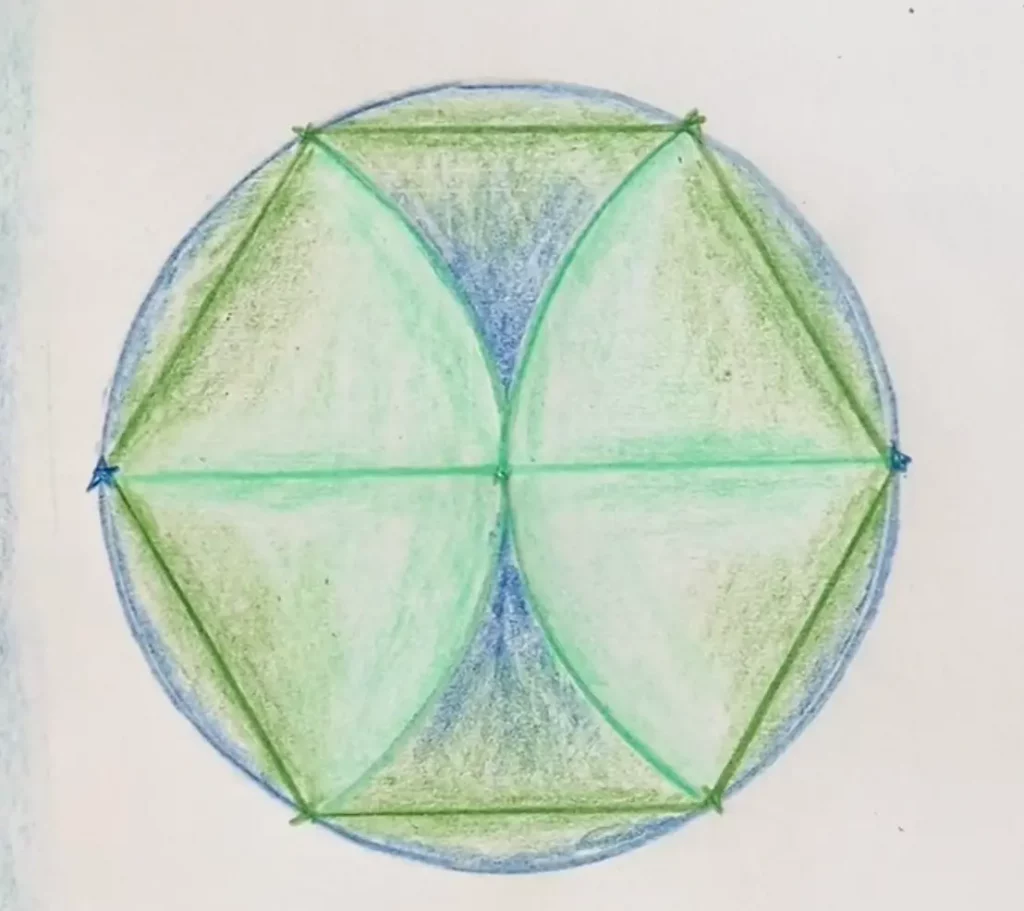When we consider the best method for teaching geometry, we should consider how to compose such a curriculum. Like the movements in a symphony, teaching geometry should follow a natural and beautiful logic based on the developing human being. It should unfold in an arc that parallels the blossoming capacities of the adolescent and harmonizes therewith.
Teaching Geometry in 5th Grade
In the Steiner (Waldorf) method, we begin teaching geometry in 5th grade with geometric constructions. We draw beautiful forms, especially the multifold divisions of circles. In 5th grade, we do this freehand for a reason I will later elaborate. No compasses and rulers are allowed, yet.

Accompanying these creations we teach the qualities of the numbers these pictures represent. Numbers are not just arbitrary symbols depicting amounts of things. They are beings. In the example above, we depict the number 7 which has qualities like divine truth. That’s why it’s said human beings have 7 chakras, that there are 7 levels of heaven, 7 classical planets, 7 homeopathic metals, and so on. 7 is a geometry of sacredness.
This way of teaching math points to a deeper geometry woven throughout nature and reality itself. We preserve the imagination of students even in more intellectual topics, which is hard to do. This prevents them from becoming hardened materialists later in life and may even keep them healthy as they age. (We highlighted this in last week’s post about how to teach math in a way that enlivens students.)
Teaching Geometry in 6th Grade
If teaching geometry in 5th grade is done freehand, we introduce the compass and straight edge (ruler) starting in 6th grade. It’s ideal not to do it before this time if we want to harmonize with the developing child because using these precision tools invites a whole new level of cognitive development better suited to the 6th grader. Geometric constructions now become riddles, not just beautiful works of art (although, they remain as such). In 6th grade, students wrestle with how to make, for example, a hexagon in a circle using only curves, straight lines, and the points established by their intersections. Can you do that?

After they have won the way to make each construction – yes, they must win it through their effort – we ask students to write out logical instructions for how to complete such constructions. This is challenging, but it develop the capacity for clear thinking, something the students must own if they one day wish to become happy and successful in life.

Teaching Geometry in 7th Grade
From the freehand art-based geometry of 5th grade, to the precision-based geometric riddles of 6th grade, teaching geometry in 7th grade becomes sublime science. Coincident with the teaching of the Renaissance, we recapitulate the discoveries of geniuses like Fibonacci and Pythagoras. Students apply precision tools and their budding algebraic thinking to discover the divine principles inherent in the world, such as the Golden Ratio.

This skillfully meets the intellectual “teeth” of the 7th grader. It helps keep the inevitable disdain and disrespect at bay as they stay inspired. It also conveys a deep respect for the underlying truths of the world. At a time when they start asking, “WHY DO I HAVE TO LEARN THIS?” the beauty and order of the work, itself, becomes the answer.
Teaching geometry in 7th grade also introduces them to proofs. Like the logical instruction-writing of 6th grade, geometric proofs exercise their ability to demonstrate truth. Truth emancipates itself from merely, “what feels right.” There’s nothing wrong with feelings, but efficacy in life depends on the ability to prove or disprove them. Feelings provide the hunch; rigorous effort makes it truth. Try that next time you get into an argument with your 7th grader.
Why this matters so much
Grade school is a time to enkindle enthusiasm. (Now you know the meaning behind our name). This is imperative even in the middle school years when sarcasm and criticism take root like weeds in the soul. Even so, adolescents need to learn how to think with their hearts before their heads. Very much is at stake in this. If we fail to enthuse them at this age with the beauty of truth, we risk them becoming nihilists later in life who think life is meaningless. We risk them learning to seek pleasure only in what is sensory, missing the super-sensory pleasures which are the most life-giving and enduring.
Our method recapitulates history
The practice of geometry evolved from practical to theoretical. It started as a practical craft by Ancient Egyptians and Babylonians who used ropes to create right triangles for architecture and for lay out farm fields, among other uses. By the rise of the Ancient Greeks, however, they used geometry not just to master the outer landscape but also the inner soul life. Geniuses like Euclid began practicing it to develop the thinking. This same arc lives in our math curriculum, especially geometry.
Teaching geometry in the light of child development
The genius of the Steiner curriculum lies in its recognition of what is appropriate at each stage of the developing child. Just as we should not ask a plant to produce a seed before the stages of bud and blossom are complete, so too should we not ask a child to produce certain academics until certain ages. This is not dogma, it is science. Just look at the difference in the muscle tone between a 5th and 6th grader and you will see in the physiognomy of the former why they are not ideally suited yet for teaching geometry with precision tools. It’s not that they can’t use them. However, they won’t be nearly as soul edified by them as if they were a year older. We can read deeper truths in these outer pictures if we know the right spiritual-scientific language.
Our approach to teaching geometry should be like the growing plant, like the unfolding symphony.
How we can help you
Enkindle Academy offers prerecorded and live lessons for students in grades 5-9. We teach all academic subjects plus fine arts, creative writing, and empowerment groups for teens. We also offer 1-on-1 tutoring on all subjects including fine arts. Visit our website for more info and for free sample lessons, and remember to subscribe for weekly updates, tips for homeschooling, and special offers.

Leave a Reply
You must be logged in to post a comment.